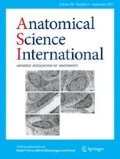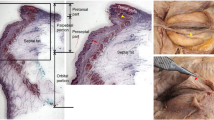Abstract
The orbicularis oculi muscle, an important mimetic muscle, was investigated to ascertain its anatomical relation to facial aging—especially its orbital part (Oo). Previous studies of the distinct muscle bundles frequently found inferior to the Oo have provided various definitions, including that of the malaris muscle. This study aimed to examine these muscle bundles and clarify their function in facial aging. Twelve heads of Japanese cadavers (average age: 82.5 years old) were dissected to observe the muscles, focusing in particular on those in the periorbital region. Six specimens were further dissected from the inner surfaces to examine the patterns of facial nerve branches under the operating microscope. Histological examinations of two head halves were carried out to investigate the relationship between the muscle bundles and the intraorbital structures. Muscle bundles consisting of lateral, medial, and U-shaped suspending bundles were observed in the region inferior to the Oo. Lateral and suspending bundles were found in all specimens, while the medial bundles were noted in only 9 of 22 specimens. Some branches of the facial nerve penetrated through the lateral, medial, and suspending bundles. The relationship between the suspending bundles and the protruding orbital fat was assessed. The muscle bundles found in this study were regarded as the malaris muscle—a transitional muscle between the superficial and deep facial layers. The suspending bundle may play a role in sustaining the intraorbital structures.







Similar content being viewed by others
References
Alghoul M, Codner MA (2013) Retaining ligaments of the face: review of anatomy and clinical applications. Aesthet Surg J 33(6):769–782
Besins T (2004) The “R.A.R.E.” technique (reverse and repositioning effect): the renaissance of the aging face and neck. Aesth Plast Surg 28(3):127–142
Carriquiry CE, Seoane OJ, Londinsky M (2006) Orbicularis transposition flap for muscle suspension in lower blepharoplasty. Ann Plast Surg 57(2):138–141
Christensen KN, Macfarlane DF, Pawlina W, King M, Lachman N (2016) A conceptual framework for navigating the superficial territories of the face: relevant anatomic points for the dermatologic surgeon. Clin Anat 29(2):237–246
del Campo AF (2008) Update on minimally invasive face lift technique. Aesthet Surg J 28(1):51–61
Flint PW, Haughey BH, Niparko JK, Richardson MA, Lund VJ, Robbins KT et al (2010) Cummings otolaryngology: head and neck surgery, 5th edn. Mosby Elsevier, Philadelphia
Fogli A (1992) Orbicularis oculi muscle and crow’s feet. Pathogenesis and surgical approach. Ann Chir Plast Esthet 37(5):510–518
Freilinger G, Gruber H, Happak W, Pechmann U (1987) Surgical anatomy of the mimic muscle system and the facial nerve: importance for reconstructive and aesthetic surgery. Plast Reconstr Surg 80(5):686–690
Furnas DW (1978) Festoons of orbicularis muscle as a cause of baggy eyelids. Plast Reconstr Surg 61(4):540–546
Goldberg RA, McCann JD, Fiaschetti D, Ben Simon GJ (2005) What causes eyelid bags? Analysis of 114 consecutive patients. Plast Reconstr Surg 115(5):1395–1402
Hamra ST (1992) Repositioning the orbicularis oculi muscle in the composite rhytidectomy. Plast Reconstr Surg 90(1):14–22
Henle J (1858) Handbuch der Systematischen Anatomie des Menschen. Bd. 1. Abt. 3. Handbuch der Muskellehre des Menschen. Braunschweig, Druck und Verlag von Friedrich Vieweg und Sohn
Hwang K, Lee DK, Chung IH, Chung RS, Lee SI (2002) Identity of ‘orbitozygomatic muscle’. J Craniofac Surg 13(2):202–204
Juhász ML, Marmur ES (2015) Temporal fossa defects: techniques for injecting hyaluronic acid filler and complications after hyaluronic acid filler injection. J Cosmet Dermatol 14(3):254–259
Lightoller GHS (1925) Facial muscles: the modiolus and muscles surrounding the rima oris with some remarks about the panniculus adiposus. J Anat 60:1–85
Marur T, Tuna Y, Demirci S (2014) Facial anatomy. Clin Dermatol 32(1):14–23
Mendelson B, Wong CH (2013) Anatomy of the aging face. In: Neligan PC, Warren RJ, Van Beek A (eds) Plastic surgery, 3rd edn. Elsevier Saunders, London, pp 78–92
Most SP, Mobley SR, Larrabee WF Jr (2005) Anatomy of the eyelids. Facial Plast Surg Cl 13(4):487–492
Okuda I, Irimoto M, Nakajima Y, Sakai S, Hirata K, Shirakabe Y (2012a) Using multidetector row computed tomography to evaluate baggy eyelid. Aesth Plast Surg 36:290–294
Okuda I, Nakajima Y, Hirata K, Irimoto M, Shirakabe Y (2012b) Imaging anatomy of the facial superficial structures and imaging descriptions of facial aging. Jpn J Diagn Imaging 30(2):117–126
Ouattara D, Vacher C, de Vasconcellos JJ, Kassanyou S, Gnanazan G, N’Guessan B (2004) Anatomical study of the variations in innervation of the orbicularis oculi by the facial nerve. Surg Radiol Anat 26(1):51–53
Park JT, Youn KH, Hur MS, Hu KS, Kim HJ, Kim HJ (2011) Malaris muscle, the lateral muscular band of orbicularis oculi muscle. J Craniofac Surg 22(2):659–662
Park JT, Youn KH, Lee JG, Kwak HH, Hu KS, Kim HJ (2012) Medial muscular band of the orbicularis oculi muscle. J Craniofac Surg 23(1):195–197
Pottier F, El-Shazly NZ, El-Shazly AE (2008) Aging of orbicularis oculi: anatomophysiologic consideration in upper blepharoplasty. Arch Facial Plast Surg 10(5):346–349
Roostaeian J, Rohrich RJ, Stuzin JM (2015) Anatomical considerations to prevent facial nerve injury. Plast Reconstr Surg 135(5):1318–1327
Spiegel JH, DeRosa J (2005) The anatomical relationship between the orbicularis oculi muscle and the levator labii superioris and zygomaticus muscle complexes. Plast Reconstr Surg 116(7):1937–1942
Standring S (2015) Gray’s anatomy: the anatomical basis of clinical practice, 41st edn. Elsevier, Amsterdam
Turvey TA, Golden BA (2012) Orbital anatomy for the surgeon. Oral Maxillofac Surg Clin North Am 24(4):525–536
Zufferey JA (2005) Cheekbone: dynamic and anti-aging structure of the midface? Eur J Plast Surg 27(8):359–366
Zufferey JA (2013) Is the malaris muscle the anti-aging missing link of the midface? Eur J Plast Surg 36(6):345–352
Acknowledgements
The authors express their grateful appreciation to all cadaver donors as well as their families for donating to the Department of Anatomy, Tokyo Medical and Dental University, Japan.
Author information
Authors and Affiliations
Corresponding author
Ethics declarations
Conflict of Interest
The authors declare that they have no conflict of interest.
Rights and permissions
About this article
Cite this article
Kampan, N., Tsutsumi, M., Okuda, I. et al. The malaris muscle: its morphological significance for sustaining the intraorbital structures. Anat Sci Int 93, 364–371 (2018). https://doi.org/10.1007/s12565-017-0422-x
Received:
Accepted:
Published:
Issue Date:
DOI: https://doi.org/10.1007/s12565-017-0422-x




